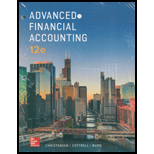
a.
Introduction: Consolidation is the process of combining financial results of various subsidiaries with the financial results of parent company. It is used only when parent company holds more than 50% of share of subsidiary company.
Bond: Bond is an instrument issued by the companies to fulfil their need of large amount of borrowings. It is the instrument of indebtedness where issuer is obliged to pay the interest on it.
The amount of interest expense to be reported in consolidates income statement.
b.
Introduction: Consolidation is the process of combining financial results of various subsidiaries with the financial results of parent company. It is used only when parent company holds more than 50% of share of subsidiary company
Loss or gain on bond retirement: When a company buyback its bonds for certain purpose, then it is called bond retirement. Loss or gain in bond retirement is difference between the carrying amount of both the companies i.e. issuing company and purchasing company.
Gain or loss on bond retirement.
c.
Introduction: Consolidation is the process of combining financial results of various subsidiaries with the financial results of parent company. It is used only when parent company holds more than 50% of share of subsidiary company
The
Want to see the full answer?
Check out a sample textbook solution
Chapter 8 Solutions
ADVANCED FINANCIAL ACCT.(LL) >CUSTOM<
- If the company uses full costing, the ending inventory for the year would be valued at ______.arrow_forwardAlicia Logistics purchased a conveyor belt system for its distribution center at a cost of $105,800. The system has an estimated residual value of $8,600 and an estimated useful life of 12 years. What is the amount of the annual depreciation computed by the straight-line method?arrow_forwardI am looking for help with this general accounting question using proper accounting standards.arrow_forward
- Nirvana Technologies has $85,000 in assets. They also have $32,000 in liabilities and $8,500 in expenses, and they paid out $10,000 in dividends this year. The extended accounting equation is assets = liabilities + (revenue - (expenses + dividends)). What would their revenue need to be for their accounts to be in balance?arrow_forwardThe per unit manufacturing cost under absorption costing is?arrow_forwardI need help with this financial accounting problem using proper accounting guidelines.arrow_forward
- Principles of Accounting Volume 1AccountingISBN:9781947172685Author:OpenStaxPublisher:OpenStax College
 Financial AccountingAccountingISBN:9781305088436Author:Carl Warren, Jim Reeve, Jonathan DuchacPublisher:Cengage Learning
Financial AccountingAccountingISBN:9781305088436Author:Carl Warren, Jim Reeve, Jonathan DuchacPublisher:Cengage Learning Intermediate Accounting: Reporting And AnalysisAccountingISBN:9781337788281Author:James M. Wahlen, Jefferson P. Jones, Donald PagachPublisher:Cengage Learning
Intermediate Accounting: Reporting And AnalysisAccountingISBN:9781337788281Author:James M. Wahlen, Jefferson P. Jones, Donald PagachPublisher:Cengage Learning


